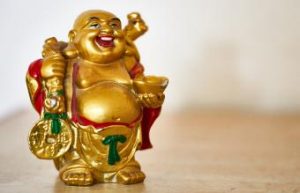Buddha Statue Meanings: 8 Symbolic Poses and Postures
Buddha statue meanings represent a certain period of Gautama Buddha’s, also known as Buddha, spiritual life. You can employ the hand movements (mudras) of a Buddha statue in feng shui uses to convey certain messages.
Meaning of Buddha Statue
Various Buddha sculptures are employed in feng shui to draw chi energy and re-direct it throughout your house, business, and garden space. Buddha statues come in a wide variety of positions and styles. But it’s helpful to know the significance and symbolism of each statue in connection to the location where you want to put it before you start buying.
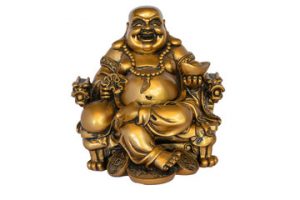
Buddha Statues of Various Types
Think about the various Buddha statue types that are available before making your ultimate decision. Each has a distinct purpose and setting in your house, workplace, or garden.
- Meditation Meaning of Buddha Statue
The Practice Amitabha, the Buddha of Boundless Light, is another name for Buddha. The Buddha is shown in the statue in what is called a double or single lotus pose, which is a sitting position. He is seated with his hands in the cosmic mudra, a meditation position. This pose’s overall profile forms a triangle that is designed to symbolize stability.
The following are additional details of this pose:
- In order to represent the Buddha’s meditative state, his eyes are either closed or or partially closed.
- The hands of the Buddha are intertwined, with the palms of his right hand resting on top of the fingers of his left hand.
- The oval shape created by the thumb tips touching each other represents focusing one’s focus inward.
A common position for a Buddhist home altar is the statue of the Buddha in meditation. Since the Buddha focused on the sun rising throughout his quest for enlightenment, the statue should face east. The statue of the Meditation Buddha can also be positioned in an area that you find tranquil and reassuring.
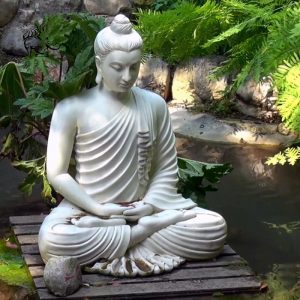
- Laughing Buddha
An imposing, balding man with a pot belly, Laughing Buddha. Hotei, a cheery Buddhist monk who lived in the latter part of the tenth century AD, served as the model for this Buddha. Unlike some Buddha statues, the Laughing Buddha has several postures and connotations depending on where you place him and how he is facing. The Laughing Buddha represents luck and abundance in its broadest sense.
- The Laughing Buddha in a standing position symbolizes accepting and celebrating enormous fortune and happiness.
- The wandering Laughing Buddha represents wealth and success.
- The Laughing Buddha in a sitting position represents balance and the maintenance of balance in all spheres of life.
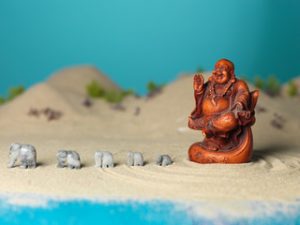
- Standing Statue of a Laughing Buddha
The Laughing Buddha statue is likely the one that is used the most in Western culture. It is sometimes referred to as the Buddha of Abundance, Prosperity, or Good Luck. In his older years, the Buddha is shown to be content and to have a full belly from a prosperous lifetime. He will either be standing or sitting with his hands supporting a real or hypothetical Ru-Yi pot (vessel or bowl of plenty).
This statue is known as Happy with affection. It’s customary to rub his tummy to guarantee that you receive even better luck. Place this statue in the southeast corner of your home or in your personal wealth corner. An office facing everyone entering on the north wall would be ideal.
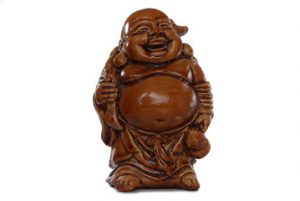
- Laughing Buddha with Kids
Children, frequently five tiny ones, are shown with the laughing Buddha, either sitting by his feet or climbing all over him. The Laughing Buddha with children represents happiness for your family, particularly for your children. The meaning of the sitting Buddha is to balance life and priorities.
You should position the Laughing Buddha with Children in your home’s west corner (for descendants’ luck). The Buddha statue should face your house if it is placed in a garden.
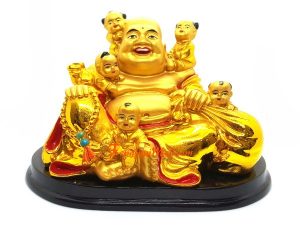
5. Wealth Ball or Laughing Buddha with Beads
The wealth ball or Laughing Buddha with beads has symbolism of meditation with the beads representing pearls of wisdom. The wealth ball symbol is a representation of prosperity as well as money.
You can put the beaded laughing Buddha in the northeast corner (education luck). Place the statue of the Laughing Buddha with a wealth ball or balls in the southeast corner (wealth luck). This statue can be positioned so that it faces your Sheng Chi direction if you are aware of it based on your Kua number.
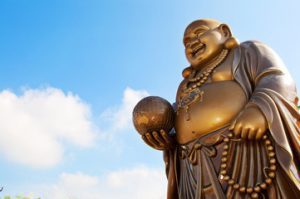
- Meaning of Laughing Buddha Holding Bowl
The Laughing Buddha holding a bowl is an accurate representation of the daily existence of a monk who relies on food and alms. Buddhist monks carry sacrifice bowls down the street for the faithful to fill with their daily food. This consistent display represents the monks’ vow to forego material belongings in their quest for enlightenment. Some statues have an orange in the bowl, while others use an ingot in its place.
Your meditation room or her shed would be the appropriate location for this Buddha. If you don’t have access to a space like that, you can put the Laughing Buddha and a bowl in a reading nook or another quiet spot where you meditate or pray.
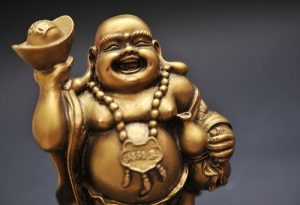
- Laughing Buddha with Fan
Another illustration of happiness is the statue of the Laughing Buddha holding a fan. Many Buddhists think that by blowing a fan in front of the Buddha statue, their problems will vanish. You are reminded to appreciate life and your good fortune by the Buddha statue. If the Buddha is also sporting a prayer bead necklace, a fan in one hand, and a Wu Lou (gourd) of enlightenment dangling from a pole.
The Laughing Buddha and a fan can be placed in your home office or place of work. This positioning of the Buddha statue drives your rivals and any potential supporters away. You can position the statue of the Laughing Buddha with Wu Lou and the fan in either the northeast sector (for luck in schooling) or southwest sector (love and relationship luck).
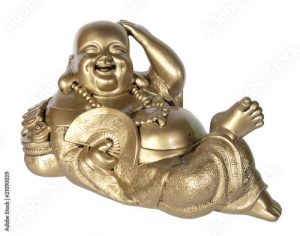
8. Traveling Statue of the Laughing Buddha
The monk with the wealth ball is frequently depicted holding the Laughing Buddha with a cotton sack draped over one shoulder or fastened to the end of a stick. The Laughing Buddha is seen in some statues holding a fan in one hand. The fan offers protection while you travel, and the bag symbolizes a bag full of benefits.
